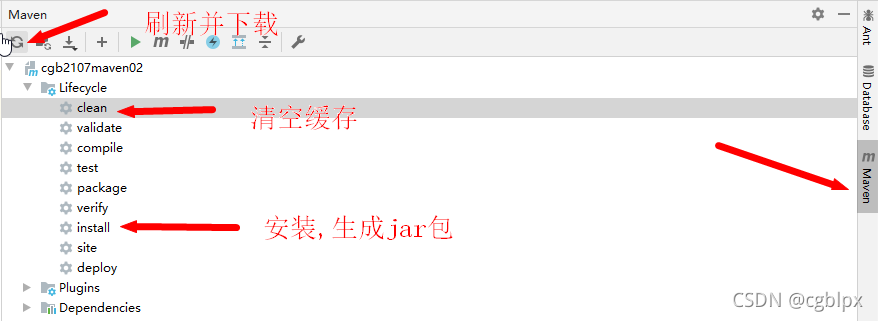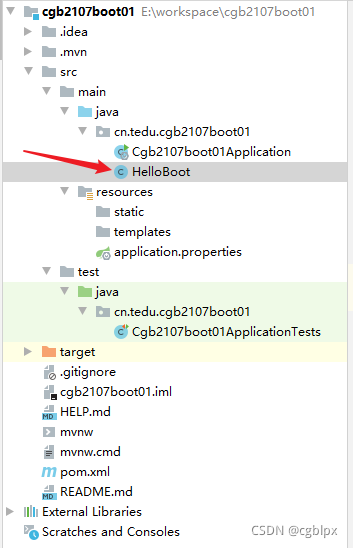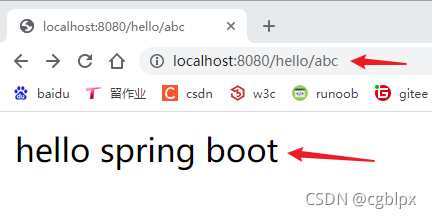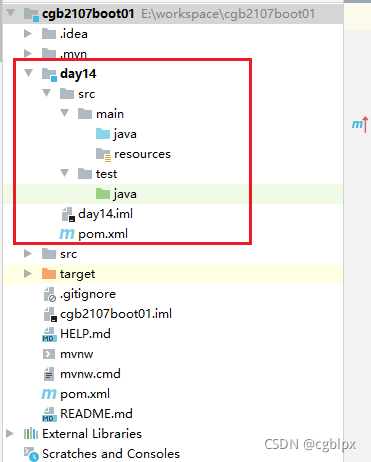文章目录
- 一,Maven
- --1,概述
- --2,使用步骤
- 二,在IDEA里用maven
- --1,创建Maven工程
- --2,配置maven
- --3,修改pom.xml文件,添加jar包的坐标
- --4,检查本地仓库
- 5,常用的maven命令
- 三,Spring Boot
- --1,概述
- --2,项目结构
- --3,创建Spring Boot工程
- --4,给工程配置maven信息
- --5,spring boot的pom.xml
- 四,给服务器添加资源
- --1,项目结构
- --2,添加HelloBoot类
- --3,重启服务器
- --4,测试
- 五,SpringMVC
- --1,概述
- --2,工作原理
- --3,测试
- 创建maven module
- 创建启动类
一,Maven
–1,概述
管理jar包: 下载,保存,编译,更新…
仓库:
1,远程仓库/中央仓库: 本质山就是一个国外的网址
2,镜像仓库: 就是一个国内的网址,已经帮你下载好了jar包
3,本地仓库: 就是一个你自己创建的文件夹,存放下载好的jar包的(D:\Java\maven\resp)
坐标: 存放jar包的路径
依赖: Ajar包可能会依赖着好多jar包,maven都会管理所有jar包
–2,使用步骤
1,解压maven压缩包,能找到settings.xml文件,需要改两处(本地仓库+镜像仓库)
2,settings.xml文件
<?xml version="1.0" encoding="UTF-8"?>
<!--
Licensed to the Apache Software Foundation (ASF) under one
or more contributor license agreements. See the NOTICE file
distributed with this work for additional information
regarding copyright ownership. The ASF licenses this file
to you under the Apache License, Version 2.0 (the
"License"); you may not use this file except in compliance
with the License. You may obtain a copy of the License at
http://www.apache.org/licenses/LICENSE-2.0
Unless required by applicable law or agreed to in writing,
software distributed under the License is distributed on an
"AS IS" BASIS, WITHOUT WARRANTIES OR CONDITIONS OF ANY
KIND, either express or implied. See the License for the
specific language governing permissions and limitations
under the License.
-->
<!--
| This is the configuration file for Maven. It can be specified at two levels:
|
| 1. User Level. This settings.xml file provides configuration for a single user,
| and is normally provided in ${user.home}/.m2/settings.xml.
|
| NOTE: This location can be overridden with the CLI option:
|
| -s /path/to/user/settings.xml
|
| 2. Global Level. This settings.xml file provides configuration for all Maven
| users on a machine (assuming they're all using the same Maven
| installation). It's normally provided in
| ${maven.conf}/settings.xml.
|
| NOTE: This location can be overridden with the CLI option:
|
| -gs /path/to/global/settings.xml
|
| The sections in this sample file are intended to give you a running start at
| getting the most out of your Maven installation. Where appropriate, the default
| values (values used when the setting is not specified) are provided.
|
|-->
<settings xmlns="http://maven.apache.org/SETTINGS/1.0.0"
xmlns:xsi="http://www.w3.org/2001/XMLSchema-instance"
xsi:schemaLocation="http://maven.apache.org/SETTINGS/1.0.0 http://maven.apache.org/xsd/settings-1.0.0.xsd">
<!-- localRepository
| The path to the local repository maven will use to store artifacts.
|
| Default: ${user.home}/.m2/repository
-->
<localRepository>D:\Java\maven\resp</localRepository>
<!-- interactiveMode
| This will determine whether maven prompts you when it needs input. If set to false,
| maven will use a sensible default value, perhaps based on some other setting, for
| the parameter in question.
|
| Default: true
<interactiveMode>true</interactiveMode>
-->
<!-- offline
| Determines whether maven should attempt to connect to the network when executing a build.
| This will have an effect on artifact downloads, artifact deployment, and others.
|
| Default: false
<offline>false</offline>
-->
<!-- pluginGroups
| This is a list of additional group identifiers that will be searched when resolving plugins by their prefix, i.e.
| when invoking a command line like "mvn prefix:goal". Maven will automatically add the group identifiers
| "org.apache.maven.plugins" and "org.codehaus.mojo" if these are not already contained in the list.
|-->
<pluginGroups>
<!-- pluginGroup
| Specifies a further group identifier to use for plugin lookup.
<pluginGroup>com.your.plugins</pluginGroup>
-->
</pluginGroups>
<!-- proxies
| This is a list of proxies which can be used on this machine to connect to the network.
| Unless otherwise specified (by system property or command-line switch), the first proxy
| specification in this list marked as active will be used.
|-->
<proxies>
<!-- proxy
| Specification for one proxy, to be used in connecting to the network.
|
<proxy>
<id>optional</id>
<active>true</active>
<protocol>http</protocol>
<username>proxyuser</username>
<password>proxypass</password>
<host>proxy.host.net</host>
<port>80</port>
<nonProxyHosts>local.net|some.host.com</nonProxyHosts>
</proxy>
-->
</proxies>
<!-- servers
| This is a list of authentication profiles, keyed by the server-id used within the system.
| Authentication profiles can be used whenever maven must make a connection to a remote server.
|-->
<servers>
<!-- server
| Specifies the authentication information to use when connecting to a particular server, identified by
| a unique name within the system (referred to by the 'id' attribute below).
|
| NOTE: You should either specify username/password OR privateKey/passphrase, since these pairings are
| used together.
|
<server>
<id>deploymentRepo</id>
<username>repouser</username>
<password>repopwd</password>
</server>
-->
<!-- Another sample, using keys to authenticate.
<server>
<id>siteServer</id>
<privateKey>/path/to/private/key</privateKey>
<passphrase>optional; leave empty if not used.</passphrase>
</server>
-->
</servers>
<!-- mirrors
| This is a list of mirrors to be used in downloading artifacts from remote repositories.
|
| It works like this: a POM may declare a repository to use in resolving certain artifacts.
| However, this repository may have problems with heavy traffic at times, so people have mirrored
| it to several places.
|
| That repository definition will have a unique id, so we can create a mirror reference for that
| repository, to be used as an alternate download site. The mirror site will be the preferred
| server for that repository.
|-->
<mirrors>
<!-- mirror
| Specifies a repository mirror site to use instead of a given repository. The repository that
| this mirror serves has an ID that matches the mirrorOf element of this mirror. IDs are used
| for inheritance and direct lookup purposes, and must be unique across the set of mirrors.
|
<mirror>
<id>mirrorId</id>
<mirrorOf>repositoryId</mirrorOf>
<name>Human Readable Name for this Mirror.</name>
<url>http://my.repository.com/repo/path</url>
</mirror>
-->
<!-- 达内私服地址 -->
<!--<mirror>
<id>nexus</id>
<name>Tedu Maven</name>
<mirrorOf>*</mirrorOf>
<url>http://maven.tedu.cn/nexus/content/groups/public/</url>
</mirror>-->
<!--阿里私服地址-->
<mirror>
<id>ali</id>
<name>ali Maven</name>
<mirrorOf>*</mirrorOf>
<url>https://maven.aliyun.com/repository/public/</url>
</mirror>
</mirrors>
<!-- profiles
| This is a list of profiles which can be activated in a variety of ways, and which can modify
| the build process. Profiles provided in the settings.xml are intended to provide local machine-
| specific paths and repository locations which allow the build to work in the local environment.
|
| For example, if you have an integration testing plugin - like cactus - that needs to know where
| your Tomcat instance is installed, you can provide a variable here such that the variable is
| dereferenced during the build process to configure the cactus plugin.
|
| As noted above, profiles can be activated in a variety of ways. One way - the activeProfiles
| section of this document (settings.xml) - will be discussed later. Another way essentially
| relies on the detection of a system property, either matching a particular value for the property,
| or merely testing its existence. Profiles can also be activated by JDK version prefix, where a
| value of '1.4' might activate a profile when the build is executed on a JDK version of '1.4.2_07'.
| Finally, the list of active profiles can be specified directly from the command line.
|
| NOTE: For profiles defined in the settings.xml, you are restricted to specifying only artifact
| repositories, plugin repositories, and free-form properties to be used as configuration
| variables for plugins in the POM.
|
|-->
<profiles>
<!-- profile
| Specifies a set of introductions to the build process, to be activated using one or more of the
| mechanisms described above. For inheritance purposes, and to activate profiles via <activatedProfiles/>
| or the command line, profiles have to have an ID that is unique.
|
| An encouraged best practice for profile identification is to use a consistent naming convention
| for profiles, such as 'env-dev', 'env-test', 'env-production', 'user-jdcasey', 'user-brett', etc.
| This will make it more intuitive to understand what the set of introduced profiles is attempting
| to accomplish, particularly when you only have a list of profile id's for debug.
|
| This profile example uses the JDK version to trigger activation, and provides a JDK-specific repo.
<profile>
<id>jdk-1.4</id>
<activation>
<jdk>1.4</jdk>
</activation>
<repositories>
<repository>
<id>jdk14</id>
<name>Repository for JDK 1.4 builds</name>
<url>http://www.myhost.com/maven/jdk14</url>
<layout>default</layout>
<snapshotPolicy>always</snapshotPolicy>
</repository>
</repositories>
</profile>
-->
<!--
| Here is another profile, activated by the system property 'target-env' with a value of 'dev',
| which provides a specific path to the Tomcat instance. To use this, your plugin configuration
| might hypothetically look like:
|
| ...
| <plugin>
| <groupId>org.myco.myplugins</groupId>
| <artifactId>myplugin</artifactId>
|
| <configuration>
| <tomcatLocation>${tomcatPath}</tomcatLocation>
| </configuration>
| </plugin>
| ...
|
| NOTE: If you just wanted to inject this configuration whenever someone set 'target-env' to
| anything, you could just leave off the <value/> inside the activation-property.
|
<profile>
<id>env-dev</id>
<activation>
<property>
<name>target-env</name>
<value>dev</value>
</property>
</activation>
<properties>
<tomcatPath>/path/to/tomcat/instance</tomcatPath>
</properties>
</profile>
-->
</profiles>
<!-- activeProfiles
| List of profiles that are active for all builds.
|
<activeProfiles>
<activeProfile>alwaysActiveProfile</activeProfile>
<activeProfile>anotherAlwaysActiveProfile</activeProfile>
</activeProfiles>
-->
</settings>
二,在IDEA里用maven
–1,创建Maven工程
File -New -Project -选Maven-输入工程名和域名 -finish
–2,配置maven
1,找到maven: File- Settings- Build,execution…- Build Tools- Maven – 配置最后三行
2, 配置maven的解压文件的路径 和 settings.xml文件的路径
–3,修改pom.xml文件,添加jar包的坐标
<?xml version="1.0" encoding="UTF-8"?>
<project xmlns="http://maven.apache.org/POM/4.0.0"
xmlns:xsi="http://www.w3.org/2001/XMLSchema-instance"
xsi:schemaLocation="http://maven.apache.org/POM/4.0.0 http://maven.apache.org/xsd/maven-4.0.0.xsd">
<modelVersion>4.0.0</modelVersion>
<groupId>cn.tedu</groupId>
<artifactId>cgb2107maven02</artifactId>
<version>1.0-SNAPSHOT</version>
<!-- 管理jar包,提供坐标,Maven自动下载依赖的 -->
<dependencies>
<!--添加jar包,jdbc的坐标,groupId组id,artifactId是项目id,version是jar包的版本-->
<dependency>
<groupId>mysql</groupId>
<artifactId>mysql-connector-java</artifactId>
<!--jar包的版本要和数据库的版本一致,5.X的jar包对应5.X的数据库-->
<version>5.1.48</version>
<!-- <version>8.0.15</version> -->
</dependency>
</dependencies>
</project>
–4,检查本地仓库

5,常用的maven命令


三,Spring Boot
–1,概述
1,简化了Maven的操作(用啥jar包就添加一个jar包的坐标)
2,内嵌了Tomcat服务器,可以访问服务器里的程序
–2,项目结构

–3,创建Spring Boot工程



–4,给工程配置maven信息

–5,spring boot的pom.xml
<?xml version="1.0" encoding="UTF-8"?>
<project xmlns="http://maven.apache.org/POM/4.0.0" xmlns:xsi="http://www.w3.org/2001/XMLSchema-instance"
xsi:schemaLocation="http://maven.apache.org/POM/4.0.0 https://maven.apache.org/xsd/maven-4.0.0.xsd">
<modelVersion>4.0.0</modelVersion>
<groupId>cn.tedu</groupId>
<artifactId>cgb2107boot01</artifactId>
<version>0.0.1-SNAPSHOT</version>
<name>cgb2107boot01</name>
<description>Demo project for Spring Boot</description>
<properties>
<java.version>1.8</java.version>
<project.build.sourceEncoding>UTF-8</project.build.sourceEncoding>
<project.reporting.outputEncoding>UTF-8</project.reporting.outputEncoding>
<spring-boot.version>2.3.7.RELEASE</spring-boot.version>
</properties>
<!--添加jar包-->
<dependencies>
<!-- TODO 添加更多的jar包坐标 -->
<!--添加了jar包坐标,构建一个springboot工程,内嵌了Tomcat-->
<dependency>
<groupId>org.springframework.boot</groupId>
<artifactId>spring-boot-starter-web</artifactId>
</dependency>
<!--添加了jar包坐标,支持Junit单元测试-->
<dependency>
<groupId>org.springframework.boot</groupId>
<artifactId>spring-boot-starter-test</artifactId>
<scope>test</scope>
<exclusions>
<exclusion>
<groupId>org.junit.vintage</groupId>
<artifactId>junit-vintage-engine</artifactId>
</exclusion>
</exclusions>
</dependency>
</dependencies>
<dependencyManagement>
<dependencies>
<dependency>
<groupId>org.springframework.boot</groupId>
<artifactId>spring-boot-dependencies</artifactId>
<version>${spring-boot.version}</version>
<type>pom</type>
<scope>import</scope>
</dependency>
</dependencies>
</dependencyManagement>
<build>
<plugins>
<plugin>
<groupId>org.apache.maven.plugins</groupId>
<artifactId>maven-compiler-plugin</artifactId>
<version>3.8.1</version>
<configuration>
<source>1.8</source>
<target>1.8</target>
<encoding>UTF-8</encoding>
</configuration>
</plugin>
<plugin>
<groupId>org.springframework.boot</groupId>
<artifactId>spring-boot-maven-plugin</artifactId>
<version>2.3.7.RELEASE</version>
<configuration>
<mainClass>cn.tedu.cgb2107boot01.Cgb2107boot01Application</mainClass>
</configuration>
<executions>
<execution>
<id>repackage</id>
<goals>
<goal>repackage</goal>
</goals>
</execution>
</executions>
</plugin>
</plugins>
</build>
</project>
四,给服务器添加资源
–1,项目结构

–2,添加HelloBoot类
package cn.tedu.cgb2107boot01;
import org.springframework.web.bind.annotation.RequestMapping;
import org.springframework.web.bind.annotation.RestController;
//想让浏览器访问类,方法吗?必须使用两个注解才行
@RestController//作用:是springmvc框架提供的,用来让浏览器访问类的+只能用在类上
@RequestMapping("hello")//作用:规定了访问方式+可以在类上或者方法上用
public class HelloBoot {
//浏览器:http://localhost:8080/hello/abc
@RequestMapping("abc")
public String hello(){
return "hello spring boot" ;//返回给浏览器!!!
}
//浏览器:http://localhost:8080/hello/get
@RequestMapping("get")
public void get(){
System.out.println(100);
}
}
–3,重启服务器

–4,测试

五,SpringMVC
–1,概述
是Spring框架的明星产品,用来 接受浏览器发来的请求 + 并返回数据
遵循MVC思想: 主要是想要松耦合,实现代码间的高内聚, 提高代码的可维护性
M 是Model, 模型层, 用来封装数据
V 是View, 视图层, 用来展示数据
C 是Controller, 控制层 作用就是用来 接受请求和给出响应
–2,工作原理
五个核心的组件
1, 前端控制器DispatcherServlet: 接受请求并分发请求
2, 处理器映射器HandlerMapping: 根据请求,找到具体能处理请求的类名,方法名
3, 处理器适配器HandlerAdapter: 正式开始调用方法处理请求,并返回结果
4, 视图解析器ViewResolver: 把页面找到,把数据进行解析
5, 视图渲染View: 具体展示数据并返回给浏览器
–3,测试
创建maven module
选中工程-右键-New-Module-选中Maven-next-输入module名-finish

创建启动类
package cn.tedu.hello;
import org.springframework.boot.SpringApplication;
import org.springframework.boot.autoconfigure.SpringBootApplication;
@SpringBootApplication//作为启动类,用来启动服务器
public class RunApp {
public static void main(String[] args) {
//利用springboot运行指定类
SpringApplication.run(RunApp.class);
}
}